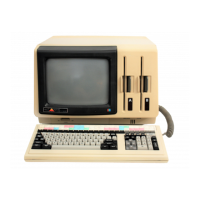CPIM-86 System Overview
1-4
CP/M-80
AND
CP/M-86
DIFFERENCES
The
structure
of
CP/M-86
is
as close to
CP/M-80
as possible. This provides a
familiar
programming
environment which allows application programs
to
be
transported
to
the 8086 processor with minimal effort. This section points
out
specific differences between
CP/M-80
and
CP/M-86
to
reduce your time in scan-
ning the
manual
if
you
are already familiar with
CP
/M-80.
The terms
and
concepts
presented in this section are explained in detail
throughout
the manual, so refer
to
the Table
of
Contents for the relevant chapters which provide specific definitions
and
information.
Relocatable Groups
The fundamental difference between
CP/M-80
and
CP/M-86
is
found in the
management
of
the various relocatable groups. Although
CP/M-80
references
absolute memory locations by necessity,
CP
/M-86
takes advantage
of
the static
relocation inherent in the 8086 processor. The
operating
system itself is
loaded
directly above the interrupt locations,
at
location 0400H,
and
relocatable transient
programs
load
in the best fit memory region. However,
you
can load
CP
/M-86
into
any
portion
of
memory
without changing the
operating
system (thus, there is
no
MOVCPM
utility with
CP
/M-86),
and
transient
programs
will
load
and
run
in
any
non-reserved region.
Memory Models
CP/M-86 is constructed as
an
8080 Model. This means
that
all the segment registers
are placed
at
the base
of
CP/M-86,
and
the CBIOS
is
identical in most respects
to
that
of
CP
IM-80
(with changes in instruction mnemonics,
of
course). In fact, the
only additions are found in the
SETDMAB,
GETSEGB,
SETIOB,
and
GETIOB
entry points in the BIOS, the additions for
hard
disk
I/O,
and
the custom
APC
features in the extended functions. The warm
start
subroutine
is simpler since
you
are
not
required
to
reload
the
CCP
and
BDOS
under
CP/M-86.
If
you
implement
the
IOBYTE facility,
you
have
to
define the variable in
your
BIOS.
Taking
these
changes
into
account,
you
need only perform a simple translation
of
your
CP/M-80
BIOS into 8086 code
to
implement the 8086 BIOS.
Disk Definition Tables
The
disk definition tables included with
CP
/M-86
for the
APC
have been deve-
loped, configured,
and
included in
the
CBIOS. Therefore, there is
no
need
to
generate
your
own disk definition tables using
GENDEF.
Bootstrap Operation
CP/M-86
resides
on
the first two tracks
of
the double-sided, double-density system
distribution diskette.
It
is
loaded by a single step
bootstrap
loader operation.

